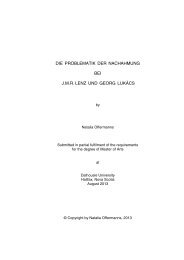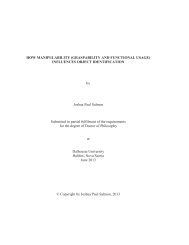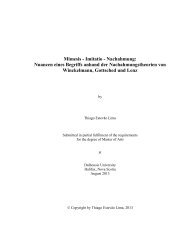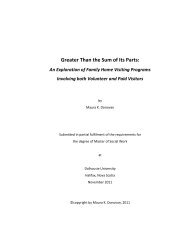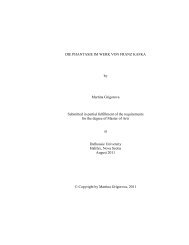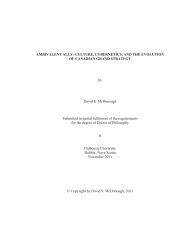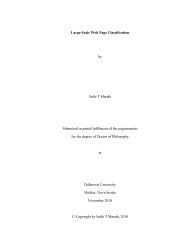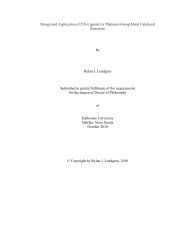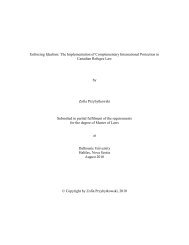ADAPTING TRISTRAM SHANDY by Adria Young Submitted in ...
ADAPTING TRISTRAM SHANDY by Adria Young Submitted in ...
ADAPTING TRISTRAM SHANDY by Adria Young Submitted in ...
You also want an ePaper? Increase the reach of your titles
YUMPU automatically turns print PDFs into web optimized ePapers that Google loves.
11 Even this is tricky, and potentially problematic. As Henry Duff Traill writes <strong>in</strong> 1882,<br />
“To talk of ‘the style’ of Sterne is almost to play one of those tricks with language of<br />
which he was so fond. For there is hardly any def<strong>in</strong>ition of the word to describe him as<br />
hav<strong>in</strong>g any style at all . . . He was determ<strong>in</strong>ed to be uniformly eccentric, regularly<br />
irregular . . . [He is] a perfect marvel of literary slipshod” (142). There is someth<strong>in</strong>g<br />
slightly <strong>in</strong>effable about Shandyism.<br />
12 The portrait of Sterne <strong>by</strong> Sir Joshua Reynolds, done <strong>in</strong> 1760, shows Sterne <strong>in</strong> his<br />
clerical robes with a smirk.<br />
13 See Chapter III, 17.<br />
14 Wayne C. Booth. “The Self-Conscious Narrator <strong>in</strong> Comic Fiction BeforeTristram<br />
Shandy” PMLA (1952): 163-185.<br />
15 Sterne sent a letter to an acqua<strong>in</strong>tance of Hogarth claim<strong>in</strong>g how wonderful it would be<br />
to have Hogarth illustrate the first two volumes; Hogarth did it. See Arthur H. Cash.<br />
Laurence Sterne: The Later Years (New York: Routledge, 1992):10-12. Also see<br />
Laurence Sterne. Letters. Ed. Lewis P. Curtis (Oxford: Oxford UP, 1935) 99.<br />
16 Sterne was not the first to <strong>in</strong>clude illustrations <strong>in</strong> his work, but they show his<br />
<strong>in</strong>vestment <strong>in</strong> the conventions of the novel, and his awareness of the marketplace and<br />
marketability. For more on novel illustration, see Thomas Keymer, Peter Sabor. “Pamela<br />
Illustrations and the Visual Culture of the Novel” 'Pamela' In the Marketplace: Literary<br />
Controversy and Pr<strong>in</strong>t Culture <strong>in</strong> Eighteenth-Century Brita<strong>in</strong> and Ireland (Cambridge:<br />
Cambridge UP, 2005): 143-176. For more on the ties between Hogarth and Sterne, see<br />
William Holtz. “The Journey and the Picture: The Art of Sterne and Hogarth” A History<br />
of Book Illustration: 29 Po<strong>in</strong>ts of View. Ed. Bill Katz (Methuen, NJ: The Scarecrow<br />
Press, 1994): 315-332.<br />
17 “Each marbled leaf <strong>in</strong> the first edition of Tristram Shandy was prepared <strong>in</strong>dividually”<br />
(Day 144). For details on the page, see W.G. Day. “Tristram Shandy: The Marbled Leaf”<br />
Library 27 (1972): 143-145. Also, De Voogd discusses the magnitude of this <strong>in</strong>clusion as<br />
representative of Sterne's <strong>in</strong>terest <strong>in</strong> materiality: “each page hand-marbled, each side<br />
different and unique, each side hand-stamped, each leaf stuck <strong>in</strong>, the sheer scope of the<br />
undertak<strong>in</strong>g a tell-tale <strong>in</strong>dication of the extent to which Sterne was prepared to go <strong>in</strong><br />
turn<strong>in</strong>g his book <strong>in</strong>to an aesthetic object” (384).<br />
18 See Wayne C. Booth. “Did Sterne Complete Tristram Shandy?” Modern Philology<br />
48.3 (1951): 172-183.<br />
19 Between 1720 and 1729, book and pamphlet production occupied 1.1% of the market,<br />
and <strong>by</strong> 1770, it had only <strong>in</strong>creased to about 4% (Fl<strong>in</strong>t 344); “religious discourse”<br />
cont<strong>in</strong>ued to dom<strong>in</strong>ate the market (Fl<strong>in</strong>t 348).<br />
20 See Ian Watt. “The Read<strong>in</strong>g Public and the Rise of the Novel” The Rise of the Novel:<br />
Studies <strong>in</strong> Defoe, Richardson, and Field<strong>in</strong>g (Berkeley: University of California Press,<br />
1957): 35-59.<br />
21 Sterne has been charged with plagiarism and defended aga<strong>in</strong>st plagiarism aplenty, on<br />
both counts. Elizabeth Kraft, for <strong>in</strong>stance, calls Sterne's Sermons largely “second-hand<br />
stuff” (26), and James Gow's dissertation, The Contexts of Sterne's Sermons, rebuts Kraft<br />
and her critical ilk, locates and identifies Sterne’s sources, and also situates Sterne’s<br />
sermon work <strong>in</strong> an ecclesiastical context of “borrow<strong>in</strong>g” (1).<br />
89



